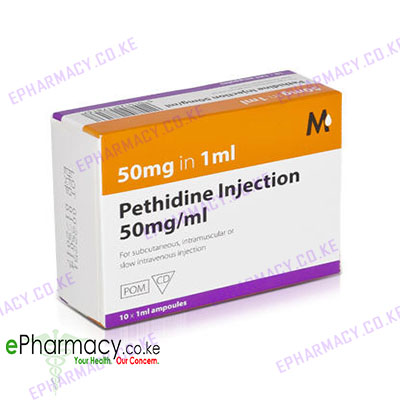Description
For the relief of pain, pethidine hydrochloride is given in doses of 50 to 150 mg by mouth every 4 hours. It may also be given by intramuscular or subcutaneous injection in doses of 25 to 100 mg and by slow intravenous injection in doses of 25 to 50 mg repeated after 4 hours. For postoperative pain the subcutaneous or intramuscular doses may be given every 2 to 3 hours if necessary.
In obstetric analgesia 50 to 100 mg may be given by intramuscular or subcutaneous injection as soon as contractions occur at regular intervals. This dose may be repeated after 1 to 3 hours if necessary up to a maximum of 400 mg in 24 hours.
In the UK, the BNFC suggests that for pain in children, those aged 2 months to 12 years may be given 0.5 to 2 mg/kg by mouth or by subcutaneous or intramuscular injection and those aged 12 to 18 years, 50 to 100 mg by mouth or 25 to 100 mg subcutaneously or intramuscularly; these doses may be repeated every 4 to 6 hours if necessary. Injection solutions may be given orally if needed, to achieve a suitable dose.
Pethidine may also be given by intravenous injection in doses of 0.5 to 1 mg/kg to neonates and children up to 12 years of age, repeated every 10 to 12 hours if necessary in those up to 2 months of age and every 4 to 6 hours if necessary in older children. Similar doses are used in those aged 1 month and over as a loading dose followed by continuous intravenous infusion of 100 to 400 micrograms/kg per hour adjusted according to response.
For pre-operative medication 25 to 100 mg may be given intramuscularly about 1 hour before surgery; children may be given 0.5 to 2 mg/kg. It may also be given subcutaneously in similar doses. As an adjunct to nitrous oxide-oxygen anaesthesia 10 to 25 mg may be given by slow intravenous injection.
Incompatibility.
Solutions of pethidine hydrochloride are acidic. They are incompatible with barbiturate salts and loss of clarity was also observed in an early additive study1 with other drugs including aminophylline, heparin sodium, meticillin sodium, morphine sulfate, nitrofurantoin sodium, phenytoin sodium, sodium iodide, sulfadiazine sodium, and sulfafurazole diolamine. Colour change from pale yellow to light green occurred when solutions of minocycline hydrochloride or tetracycline hydrochloride were mixed with pethidine hydrochloride in 5% glucose injection.2
In the same study an immediate precipitate occurred on admixture with cefoperazone sodium or mezlocillin sodium; with nafcillin sodium an immediate cloudy appearance cleared on agitation. Incompatibility has also been observed between pethidine hydrochloride and aciclovir sodium, imipenem, furosemide,3 liposomal doxorubicin hydrochloride,4 and idarubicin.5 Solutions of cefazolin sodium6 and pethidine hydrochloride mixed in 5% glucose injection turned light yellow after storage for 5 days at 25 degrees; the admixture was stable for at least 20 days at 4 degrees.
Dependence and Withdrawal
Doses of pethidine as large as 3 or 4 g daily have been taken by addicts. As tolerance to the CNS stimulant and antimuscarinic effects is not complete with these very large doses, muscle twitching, tremor, mental confusion, dilated pupils, and sometimes convulsions may be present. Withdrawal symptoms appear more rapidly than with morphine and are of shorter duration.


Reviews
There are no reviews yet.